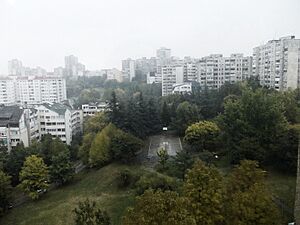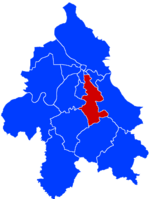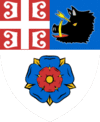Voždovac facts for kids
Quick facts for kids
Voždovac
Вождовац (Serbian)
|
||
|---|---|---|
|
Municipality
|
||

Braće Jerković neighbourhood
|
||
|
||

Location of Voždovac within the city of Belgrade
|
||
| Country | ||
| City | ||
| Status | Municipality | |
| Settlements | 5 | |
| Government | ||
| • Type | Municipality of Belgrade | |
| Area | ||
| • Municipality | 148.50 km2 (57.34 sq mi) | |
| • Urban | 56.92 km2 (21.98 sq mi) | |
| Population
(2022)
|
||
| • Municipality | 174,864 | |
| • Density | 1,177.54/km2 (3,049.80/sq mi) | |
| Time zone | UTC+1 (CET) | |
| • Summer (DST) | UTC+2 (CEST) | |
| Postal code |
11040
|
|
| Area code(s) | +381(0)11 | |
| Car plates | BG | |
Voždovac (which sounds like VOHZH-doh-vahts in Serbian) is a part of the big city of Belgrade, in Serbia. It's like a borough or a district within the city.
In 2022, about 174,864 people lived in Voždovac. It stretches out from the center of Belgrade towards the south for almost 40 kilometers (about 25 miles). Because of its long shape, it shares borders with more other parts of Belgrade than any other municipality!
Contents
History of Voždovac
The area of Voždovac became an official municipality in 1904. Over the years, it grew bigger. In 1955, another area called Pašino Brdo joined Voždovac.
Later, in the early 1960s, the village of Ripanj was also added. This made Voždovac very long, which can be tricky for people living in the far south. They have to travel over 30 kilometers (about 19 miles) to reach the main municipal office! There's been talk about making a new, smaller municipality for the southern villages, but nothing has happened yet.
Geography and Nature
Voždovac is located in the northern part of a region called Šumadija. The southern part of the municipality has forests like Lipovička šuma. The Topčiderka river flows through this area.
One of Belgrade's two famous mountains, Avala, is also in Voždovac. It's about 511 meters (1,677 feet) tall. In the northern, city part of Voždovac, you'll find hills like Torlak and Pašino Brdo.
Many small rivers and streams flow through Voždovac, including Zavojnička reka and Bubanj Potok. Even though there are big forests in the non-city parts, the main urban area only has one real park, called Šumice.
Neighborhoods and Villages
Voždovac has both busy city neighborhoods and quieter suburban villages.
City Neighborhoods
- Autokomanda
- Banjica
- Banjica II
- Braće Jerković I
- Braće Jerković II
- Braće Jerković III
- Dušanovac
- Jajinci
- Kumodraž I
- Kumodraž II
- Lekino Brdo
- Mala Utrina
- Marinkova Bara
- Medaković I
- Medaković II
- Medaković III
- Mitrovo Brdo
- Pašino Brdo
- Selo Rakovica
- Siva Stena
- Šumice
- Torlak
- Trošarina
- Veljko Vlahović
- Voždovac
Suburban Towns
- Beli Potok
- Pinosava
Suburban Villages
- Bubanj Potok
- Gaj
- Selo Kumodraž
- Ripanj
- Stepin Lug
- Šuplja Stena
- Zuce
Parts of Ripanj Village
- Bela Zemlja
- Brđani
- Čaršija
- Kablar
- Kolonija
- Prnjavor
- Stepašinovac
- Stražarija
- Trešnja
Population Changes
Voždovac has grown a lot over the years. In 1948, about 52,338 people lived there. By 2022, this number had jumped to 174,864! Even with its large natural areas, Voždovac is still a very populated place.
People of Voždovac: Ethnic Groups
Most people living in Voždovac are Serbs. Here's a look at the different groups:
| Ethnic group | Population | Percent |
|---|---|---|
| Serbs | 153,674 | 87.9% |
| Romani | 948 | 0.54% |
| Yugoslavs | 911 | 0.52% |
| Montenegrins | 520 | 0.3% |
| Macedonians | 459 | 0.26% |
| Russians | 422 | 0.24% |
| Croats | 377 | 0.22% |
| Gorani | 285 | 0.16% |
| Muslims | 214 | 0.12% |
| Bosniaks | 167 | 0.1% |
| Hungarians | 128 | 0.07% |
| Slovenians | 110 | 0.06% |
| Albanians | 95 | 0.05% |
| Bulgarians | 86 | 0.05% |
| Romanians | 59 | 0.03% |
| Slovaks | 53 | 0.03% |
| Others | 898 | 0.51% |
| Undeclared/Unknown | 15,458 | 8.84% |
| Total | 174,864 |
Local Government
Voždovac is run by a local government, led by a president. Here are some of the people who have been in charge:
- Nikola Stepanović (1952–1955)
- Vučko Ivković (1955–1956)
- Petar Kolundžija (1956–1965)
- Zoran Nastić (1965–1973)
- Munir Lasić (1973–1978)
- Dragomir Marić (1978–1982)
- Borislav Kuzmanović (1982–1986)
- Milorad Leković (1986–1988)
- Zoran Višnjić (1988–1991)
- Zoran Antonić (1991–1992)
- Božidar Simatković (1992–1994)
- Zoran Modrinić (1994–1996)
- Nebojša Atanacković (1997–2000)
- Stevan Radović (2000–2004)
- Goran Lukačević (2004–2010)
- Dragan Vukanić (2010–2014)
- Aleksandar Savić (2014–2020)
- Ivana Ilić-Tomić (2020–present)
Voždovac Neighborhood
Where is Voždovac Neighborhood?
The neighborhood of Voždovac is about 4 to 5 kilometers (2.5 to 3 miles) south of downtown Belgrade. It sits on a hill. Three main streets run through it: Bulevar Oslobođenja, Kumodraška Street, and Vojvode Stepe Street.
Voždovac borders many other neighborhoods, like Autokomanda to the north, Banjica to the west, and Kumodraž to the south.
Meaning of the Name and Its History
The name Voždovac comes from the word vožd, which means "leader" or "duke". This was one of the titles used by Karageorge Petrović, who led the First Serbian Uprising. He helped free Belgrade from the Turks in 1806. The place where he started that important operation is now where the Church of the Saint Emperor Constantine and Helena stands. People often call it the Voždovac Church.
After World War I in 1918, Voždovac became part of Belgrade. New neighborhoods were built, often named after members of the royal family. One area was called "Queen Maria's Suburb" after Maria of Yugoslavia. But over time, people started calling it Voždovac, and that name stuck.
What is Voždovac Like?
Voždovac started as a place where people lived, but it has grown and changed. The southern part, near Torlak, looks more like a rural area. However, the area stretching into Kumodraž II has become a major industrial zone in "Old Belgrade." The western part, along the Boulevard of Liberation, is known as a more upscale neighborhood.
Voždovac is also home to three important faculties (schools) of the University of Belgrade: Management, Political Sciences, and Transportation. In 2011, about 23,153 people lived in the Voždovac neighborhood itself.
The Church of the Saint Emperor Constantine and Empress Helena is a famous landmark here. It was damaged in World War I but was rebuilt. A new, larger church was opened in 1970.
Economy and Jobs
The villages in Voždovac are mostly agricultural, meaning they focus on farming. But the city part has a big industrial area, especially along Kumodraška Street. Here you'll find factories like Vatrosprem, Soko Štark, and Ratko Mitrović. Some city service companies and electricity companies also have facilities here.
The main government offices for the municipality are in Dušanovac. This area has the municipal assembly building, police and fire stations, a health center, and courts.
Major roads pass through Voždovac, including the highway connecting Belgrade to Niš. A railway also runs through the municipality.
Many people work in Voždovac. Here's a quick look at the types of jobs in 2018:
| Activity | Total |
|---|---|
| Agriculture, forestry and fishing | 172 |
| Mining and quarrying | 26 |
| align="right"|5,876 | |
| Electricity, gas, steam and air conditioning supply | 832 |
| Water supply; waste management | 1,091 |
| align="right"|5,525 | |
| Wholesale and retail trade, repair of vehicles | 10,046 |
| Transportation and storage | 2,368 |
| align="right"|1,886 | |
| align="right"|2,391 | |
| Financial and insurance activities | 756 |
| Real estate activities | 193 |
| Professional, scientific and technical activities | 4,442 |
| Administrative and support service activities | 6,070 |
| Public administration and defense; social security | 3,002 |
| align="right"|4,088 | |
| align="right"|2,782 | |
| Arts, entertainment and recreation | 1,065 |
| Other service activities | 1,027 |
| Individual agricultural workers | 25 |
| Total | 53,644 |
Sports in Voždovac
Voždovac is home to the football club FK Voždovac. They play at the Voždovac Stadium. Another important club from the municipality is Rad, which has a long history and has even played in European competitions!
Friends Around the World
Voždovac has special connections with other cities and municipalities:
 Šempeter, Slovenia (twinned)
Šempeter, Slovenia (twinned)
It also has friendship agreements with:
See also
 In Spanish: Voždovac para niños
In Spanish: Voždovac para niños


